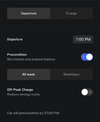I understand the purpose and benefits of preconditioning; warming the car, better range, faster charging..... What I would like like a little deeper dive on is this.
There are many ways to precondition the car. Scheduled departure, Navigation, turning climate on. Tesla states to turn the climate on to Precondition. Tesla Also says to turn on navigation so it will precondition before super charging which it does and says its doing so on the screen prior to the super charger arrival. So whats the difference between turning on climate preconditioning and the preconditioning that happens prior to supercharging in navigation? I mean climate is already on when you've been driving most likely. So if turning on climate is how you precondition at home, I don't understand whats happening with the preconditioning when it starts from navigation? Anyone have real facts on what the difference is, whats actually happening in the car? Also, if its 80 degrees out and it preconditions in Nav, is it making the battery even warmer?
There are many ways to precondition the car. Scheduled departure, Navigation, turning climate on. Tesla states to turn the climate on to Precondition. Tesla Also says to turn on navigation so it will precondition before super charging which it does and says its doing so on the screen prior to the super charger arrival. So whats the difference between turning on climate preconditioning and the preconditioning that happens prior to supercharging in navigation? I mean climate is already on when you've been driving most likely. So if turning on climate is how you precondition at home, I don't understand whats happening with the preconditioning when it starts from navigation? Anyone have real facts on what the difference is, whats actually happening in the car? Also, if its 80 degrees out and it preconditions in Nav, is it making the battery even warmer?



